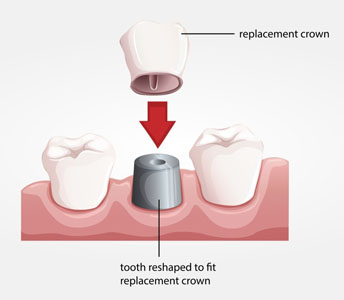 For a cosmetic dentist, there are few tools as widely used as dental crowns. When you consider the ultimate goal of cosmetic dentistry these days, there are two fundamental functions we seek to perform. This first and most important thing is that a tooth can do its job, which is to tear and chew food. To makes sure this can happen, your cosmetic dentist needs to make sure the chewing surface is not damaged or in need of repair. In fact, all dentists have this same responsibility. The second thing a cosmetic dentist does, which other dentists may not be quite as concerned about, is to ensure the tooth you have repaired looks as good, or better, than the teeth surrounding it. This gives you the peace of mind to smile freely without being concerned about a tooth or teeth that stand out.
For a cosmetic dentist, there are few tools as widely used as dental crowns. When you consider the ultimate goal of cosmetic dentistry these days, there are two fundamental functions we seek to perform. This first and most important thing is that a tooth can do its job, which is to tear and chew food. To makes sure this can happen, your cosmetic dentist needs to make sure the chewing surface is not damaged or in need of repair. In fact, all dentists have this same responsibility. The second thing a cosmetic dentist does, which other dentists may not be quite as concerned about, is to ensure the tooth you have repaired looks as good, or better, than the teeth surrounding it. This gives you the peace of mind to smile freely without being concerned about a tooth or teeth that stand out.
Possible treatment options
Over the years, a number of treatment options have evolved to treat people who have damaged their teeth. Damaged, broken, or chipped teeth are not attractive, tend to attract diseases in the form of bacterial infections, and are not functional for chewing. Some of the treatment options the patient will hear about are dental veneers, dental implants, dental bridges, and dental crowns. Dental crowns are not only the most commonly used dental tool but they are also the one people are most widely aware of. In popular culture, people often refer to dental crowns as dental caps or just caps.
This is an excellent way to describe what a dental crown does, which is to cap a damaged tooth to protect the enamel while giving patients the ability to chew normally. One of the functions a cosmetic dentist also fulfills is an educator, where we strive to teach patients about the procedures available and even share some of the terminologies the patient will hear around the office. As such, when patients come in for a dental crown, here are a few terms they can expect to hear.
Preparation
In order for a cosmetic dentist to properly place dental crowns, it is essential to have the right preparation. The process involves understanding the history of the tooth, which affects how we treat it. We need to know of any previous damage, any infections, and the materials that will properly shave and prepare the tooth for the new crown.
Margin
There is a critical part of the dental crown that the cosmetic dentist must make sure is perfectly smooth without any gaps and ledges. This is the part of the crown that meets the tooth, so getting it right literally has no margin for error.
Partial Crowns
A partial crown only covers the cusps, which are the pointy chewing surfaces of the tooth, instead of the whole tooth. When possible, this is the preferred way of placing crowns, as it maintains the majority of the tooth’s natural integrity with a more conservative approach to repair.
Call our office at (334) 575-3235 for an appointment or more information
Related Posts
4 Tips for Implant Crown Care
Wondering how to properly care for your new implant crown? Read on to learn some helpful tips on crown care. The amount of time you are able to keep your implant crown …
How Dental Crowns Affect Your Smile
A person’s smile is one of the first things that they show off to the world, and a dental crown is one way to bolster that smile and restore teeth that may …
4 Aftercare Tips for Implant Crowns
Implant crowns are a long-term solution to tooth loss that are easy to care for, but the process of receiving the new and beautiful replacement teeth is not always pleasant. To make …
Will I Need a Dental Crown After a Root Canal?
Dental crowns are a great restoration option used both on their own and in conjunction with other procedures such as root canals and dental implant placements. They are often recommended after a root …

